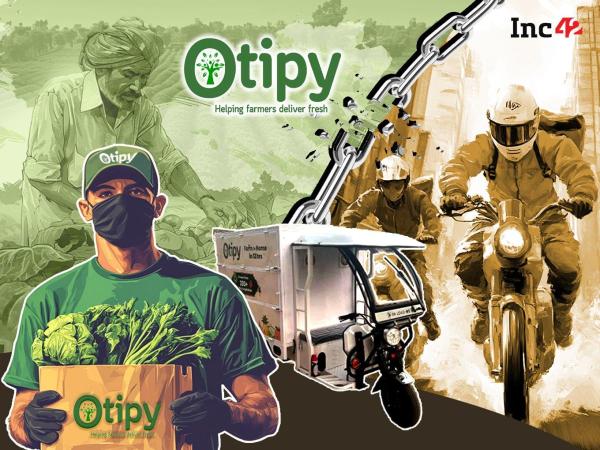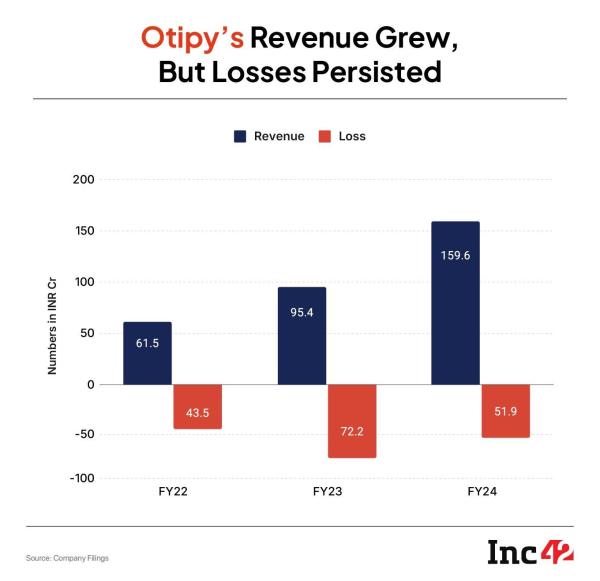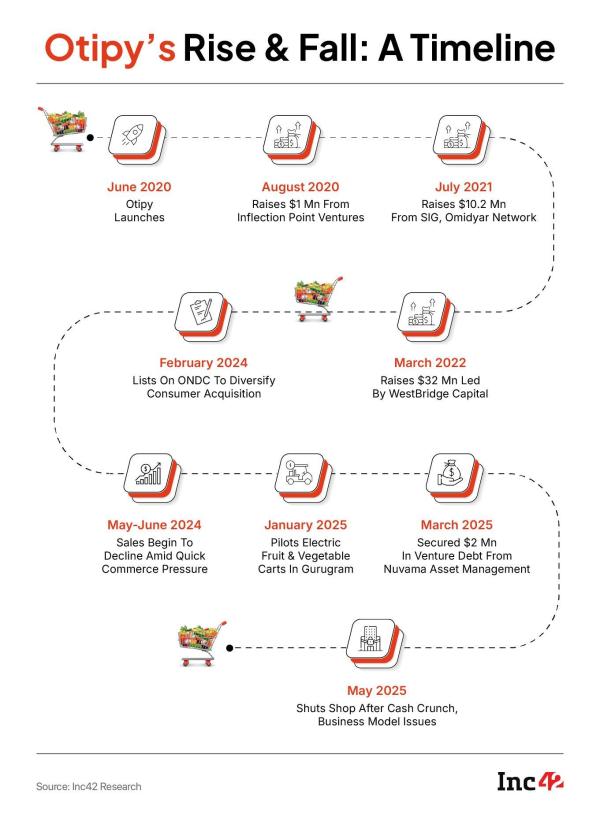
From farm to table — this is the basis on which many agritech startups were built in India. The fresh produce supply chain market in India was arguably overhyped five to six years back, and more after the pandemic.
As COVID-19 lockdowns supercharged demand for online groceries and farm-to-home deliveries, consumers started to pay premiums for freshness. There were also success stories in online grocery delivery like that of Tatas-owned BigBasket, which fuelled the belief that farm-to-table startups are here to stay.
Otipy, founded by Varun Khurana and Prashant Jain, was one of the first movers in the market. It was launched in 2020 as an agritech startup operated by Crofarm.
Gurugram-based Crofarm started out with a B2B model in 2016 to improve the supply chain for fresh fruits and vegetables, and pivoted to a B2B2C model (Otipy) in 2020.
Essentially, Otipy connected end consumers to farmers through a community of resellers who handled the last-mile delivery of fresh produce. It claimed to be India’s first community group buying platform for fresh produce and daily essentials, aiming to deliver fruits and vegetables (F&V) to consumers upon procurement from farmers directly, without the involvement of any middleman.
The operation involved sourcing fresh fruits and vegetables directly from farmers and shipping them to Otipy’s warehouses. Following quality inspection and packaging, the orders were collected by local resellers who provided doorstep delivery to end-users.
However lucrative and interesting this model looked back then, it started showing cracks and the early mover Otipy failed to sustain its run. Inc42 had last month reported exclusively that the startup had shut down.
According to Otipy employees, the management has halted all communications with them. By now, the decision to shut down operations is very clear, but the employees have not received any communication on when they would get their dues.
One employee claimed CEO Varun Khuarna has stated that the dues would be cleared in “several days” without mentioning any specific day or time.
Vendors complained that the company has not cleared dues since January. “We’ve been trying to reach them, but they’re completely unresponsive now. Earlier, the management kept assuring us that once they closed their funding round, they would settle all payments — but that never happened,” one of them told us.
“It’s frustrating, we’ve provided our services in good faith, and now we’re chasing them for what’s rightfully ours,” another vendor added.
As we stand at this juncture, let’s look back at the early promise of Otipy and its fall.
Otipy’s Fresh PromiseAt the time of launch in June 2020, Otipy had positioned itself as a B2B2C agritech startup, looking to transform India’s fragmented fresh produce supply chain. The platform connected farmers directly with consumers through a network of community resellers who managed the last-mile delivery. Otipy leveraged an AI-based demand forecasting system to optimise procurement, minimise wastes, and ensure faster delivery.
The venture was built on the insight that multiple stakeholders, such as farmers, sellers, resellers, and consumers, were underserved in the traditional supply chain. The company set out to build a model that could make fresh produce distribution faster, more affordable, and more efficient, while remaining conscious of the needs of small farmers.
Khurana, with prior experience at Grofers (now Blinkit) and MyGreenBox, launched Otipy in Delhi NCR with a sharp focus on enabling small farmers with limited landholdings and low capital access to find better market linkages beyond the traditional mandi system.
Otipy gained investor attention soon after its launch. In 2020, agritech startup Crofarm’s farm-to-fork social commerce business raised $1 Mn in seed funding from Inflection Point Ventures (IPV).
The momentum continued into 2021 when Otipy raised $10.2 Mn in Series A funding from investors such as SIG and Omidyar Network. In just six months, Otipy again raised $32 Mn in Series B funding led by WestBridge Capital, a clear indicator of the faith that investors had placed in the farm-to-fork opportunity. Following the fundraising, Otipy also expanded in Mumbai.
But even with the massive capital raised, the firm was unable to sustain operational efficiency and financial viability. Capital-intensive models of last-mile delivery, wafer-thin margins on fresh produce, and the unmanageable nature of demand forecasting in perishable categories were problems proving to be in the long run.
“The farm-to-fork concept always seemed enticing on the surface but the economics were savagely tough. Fresh food has no margin for error — wastage, logistics, and fluctuating customer demand can easily swamp the margins,” one of the investors at a Delhi-based VC firm said.
“The issue that they were attempting to resolve was two-pronged: solving wastage on the farm side and buying customers directly. You do either consolidate farmers and create a loyal set of consumers or you get bogged down somewhere in the middle. That’s what occurred here,” he added.

What’s more surprising about Otipy’s current state is that its fundraising was backed by tangible growth rather than mere hype unlike many startups which shut shop last year.
The startup showed strong revenue momentum, reporting an income of INR 160 Cr in FY24, a significant jump from INR 95 Cr in FY23. This surge reflected increasing consumer traction and an expanding supply chain footprint.
It continued to grapple with losses, albeit with some improvement in the bottomline year-on-year. Otipy reported a loss of INR 51 Cr in FY24, narrowing down from a higher loss of INR 72 Cr in FY23.
“The founders were genuinely committed and took multiple measures to keep the business afloat despite mounting challenges. They were doing everything possible to steer the company through turbulent times. You could see the hustle and grit, they didn’t just sit back and wait for things to happen,” an investor in Otipy told Inc42 on the condition of anonymity.
In a bid to scale its consumer base and diversify distribution channels, Otipy joined the government-backed Open Network for Digital Commerce (ONDC) last year. The integration allowed Otipy to list its offerings on seller apps like Pincode and Paytm, aiming to tap into ONDC’s growing multi-platform ecosystem.
The move was part of Otipy’s strategy to establish multiple consumer touchpoints beyond its own app. At the time, founder Varun Khurana had emphasised that Otipy would also double down on bulk procurement directly from farmers and Farmer Producer Organisations (FPOs) to strengthen its supply-side network.
With this expansion, the company was bullish on its ability to scale outside Delhi-NCR. Otipy projected that ONDC would significantly boost its consumer reach by enabling access to large buyer apps on the network. The startup had set ambitious targets, aiming to grow its monthly active user base from 1.5 Lakh to 10 Lakh by the end of the year.
As online sales began tapering off, Otipy piloted an offline strategy by launching electric carts in Gurugram to sell fruits and vegetables directly to consumers. The company planned to scale this initiative further to revive growth, but it ultimately remained a limited experiment as larger operational headwinds mounted.
The One Disruption That Otipy Couldn’t HandleWhat ended Otipy’s growth trajectory was the quick commerce boom. With quick commerce players expanding their categories aggressively, the consumer mentality started tilting towards instant gratification over planned purchases. This directly affected Otipy’s proposition, which was dependent on consumers planning their fresh produce orders in advance.
Initially, Otipy’s promise of farm-fresh, handpicked produce resonated with a segment of consumers willing to wait for quality. However, as platforms like Zepto, Blinkit, and Instamart started offering fresh, handpicked fruits and vegetables with delivery in under 10 minutes, Otipy’s differentiated value proposition began to erode.
“At that time when Otipy and other similar platforms started emerging, the hypothetical LTV for farm-to-fresh customers looked incredibly attractive. The assumption was that fruits and vegetables would always be in demand and if your product quality was good, sales wouldn’t drop. On paper, it looked like a sticky, high-retention, low-churn business,” a partner at a VC firm which evaluated such startups for funding deals, said.
But no one really anticipated how rapidly 10-minute delivery apps would enter and completely change consumer expectations. Suddenly, customers wanted express deliveries, and that fundamentally broke the farm-to-table unit economics, the investor added.
An Otipy employee from the operations team told us that sales began declining noticeably from May-June last year. “It became increasingly difficult to acquire new customers, and even existing ones started dropping off. We kept flagging to the management that our limited product range and longer delivery timelines were becoming major issues,” the employee said.
While the leadership explored pivoting to faster deliveries, they were apprehensive about the associated logistic complexities and the higher wastage risks that come with speed. Moreover, building the quick commerce muscle required significant capital — something Otipy was struggling to secure.
“The farm-to-fork model has a bit of a buffer when you’re delivering within 12-24 hours. But once you shrink that timeline to 10-30 minutes, the margin of error drops drastically. You need a much denser network of dark stores, real-time inventory tracking, and a hyper-efficient cold chain to pull it off. We just weren’t set up for that,” the employee added.
Other insiders added that faster deliveries would have meant a higher percentage of wastage if orders didn’t move fast enough. “In fresh produce, wastage is money lost. We also couldn’t afford overstocking at local hubs to support quick deliveries, because that would only worsen the wastage problem,” one of them said.
Since last year, Otipy has looked to raise a Series C round, but investor appetite in this space has begun cooling. Investors started to see the cracks in the farm-to-fresh model, especially with quick commerce players eating into the market.
Otipy, desperate for funds, raised $2Mn in venture debt from Nuvama Asset Management Limited earlier in March, Entrackr reported. However, it was not enough to save the agritech startup from the quick commerce storm.

The fall of Otipy was not a standalone incident in this segment this year. As agritech has traditionally remained a less discussed sector, there hasn’t been much conversation around these developments. One such story is of , which decided to cease operations earlier this year.
Started as a B2B business, Deep Rooted supplied vegetables and fruits to over 120 restaurants in Bengaluru. However, the company pivoted to a B2C model after COVID.
Deep Rooted struggled to establish a consumer-focussed model and, in early 2024, shifted back to a B2B approach on quick commerce platforms like BlinkIt and Zepto. However, it failed to achieve substantial scale there as well, according to media reports.
The investor quoted above believes there will definitely be a slowdown in farm-to-fork startups. Some of his peers have even begun calling it a dead model. However, he cautioned against rushing to a final verdict. “At least now we know what the problems in the model were, and what the core challenges are,” he said.
He cited the example of the US-based . It operates large-scale vertical farms in New Jersey and California, employing advanced robotics, AI, and natural pollination by bees to cultivate its signature Omakase strawberries. It has also expanded to berries and tomatoes, selling its products to large retailers.
According to the investor, what’s needed is a tweak where the farm-to-fork proposition remains but with a unique and easily differentiable offering.
“For customers, it’s not easy to tell the difference between an average banana and a premium one, but the kind of differentiation the likes of Oishii has created can make people willing to pay a premium. Plus, their model of partnering with retailers is something agritech startups can learn from,” he added.
He believes agritech startups should focus more on the quality and uniqueness of the fresh produce, rather than trying to sell to customers directly. “In that race, consumer internet giants can easily outcompete smaller startups,” he explained.
Now, after the shutdown of Otipy, can the farm-to-table segment in India actually meet these demands, or is that a bridge too far?
[Edited by Nikhil Subramaniam]
The post appeared first on .









